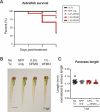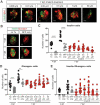Targeting polyamine biosynthesis to stimulate beta cell regeneration in zebrafish
- PMID: 32715853
- PMCID: PMC7527022
- DOI: 10.1080/19382014.2020.1791530
Targeting polyamine biosynthesis to stimulate beta cell regeneration in zebrafish
Abstract
Type 1 diabetes (T1D) is a disease characterized by destruction of the insulin-producing beta cells. Currently, there remains a critical gap in our understanding of how to reverse or prevent beta cell loss in individuals with T1D. Previous studies in mice discovered that pharmacologically inhibiting polyamine biosynthesis using difluoromethylornithine (DFMO) resulted in preserved beta cell function and mass. Similarly, treatment of non-obese diabetic mice with the tyrosine kinase inhibitor Imatinib mesylate reversed diabetes. The promising findings from these animal studies resulted in the initiation of two separate clinical trials that would repurpose either DFMO (NCT02384889) or Imatinib (NCT01781975) and determine effects on diabetes outcomes; however, whether these drugs directly stimulated beta cell growth remained unknown. To address this, we used the zebrafish model system to determine pharmacological impact on beta cell regeneration. After induction of beta cell death, zebrafish embryos were treated with either DFMO or Imatinib. Neither drug altered whole-body growth or exocrine pancreas length. Embryos treated with Imatinib showed no effect on beta cell regeneration; however, excitingly, DFMO enhanced beta cell regeneration. These data suggest that pharmacological inhibition of polyamine biosynthesis may be a promising therapeutic option to stimulate beta cell regeneration in the setting of diabetes.
Keywords: Beta cell; DFMO; difluoromethylornithine; imatinib; islet; ornithine decarboxylase; polyamine biosynthesis; regeneration; type 1 diabetes; zebrafish.
Figures




References
-
- Matthews JB, Staeva TP, Bernstein PL, Peakman M, von Herrath M, Group I-JT. 1 DCTA. Developing combination immunotherapies for type 1 diabetes: recommendations from the ITN-JDRF type 1 diabetes combination therapy assessment group. Clin Exp Immunol. 2010;160:176–184. doi:10.1111/j.1365-2249.2010.04153.x. - DOI - PMC - PubMed
-
- Megosh L, Gilmour SK, Rosson D, AP S, Blessing M, Sawicki JA, O’Brien TG. Increased frequency of spontaneous skin tumors in transgenic mice which overexpress ornithine decarboxylase. Cancer Res. 1995;55:4205–4209. - PubMed
Publication types
MeSH terms
Substances
Associated data
Grants and funding
LinkOut - more resources
Full Text Sources
Medical
Molecular Biology Databases
Miscellaneous
